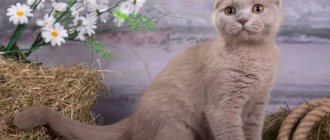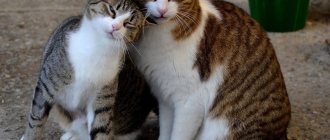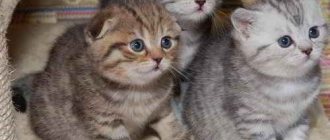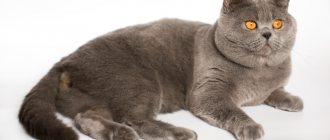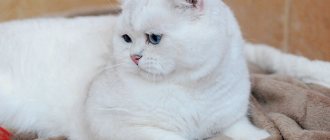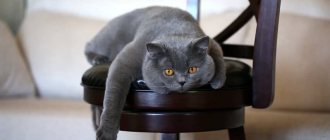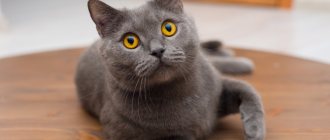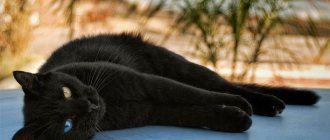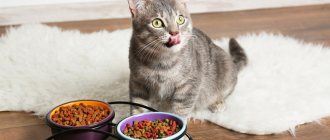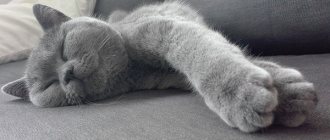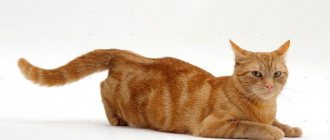History of the origin of the British cat
Judging by the name itself, it becomes clear that the homeland of these cats is Great Britain. Historians suggest that these animals were brought to the British Isles by the ancient Romans around the first century AD.
The main advantage of those ancient representatives of the British was their short and very dense coat, which provided the animals with protection from moisture and harmful insects. It was thanks to this wool that the British quickly got used to and adapted to new living conditions.
They were excellent hunters, thanks to their high levels of endurance and well-developed physical fitness.
Due to their spectacular appearance, at the end of the 16th century, British felines began to be looked at not only as skilled hunters. And already in 1871, British individuals participated in the first cat exhibition in London.
Disqualifying Faults
British cats taking part in the exhibition are primarily subject to general criteria, if identified, the animal may be disqualified:
- presence of ectoparasites;
- dirty wool;
- skin damage;
- symptoms of acute illness;
- genetic defects;
- manifestation of aggression when two different stewards cannot take the animal from the cage;
- suspicion of doping;
- signs of color falsification.
In relation to British Shorthairs, additional reasons for disqualification:
- elongated body proportions;
- depressions or protrusions that violate the structure of the head corresponding to the standard;
- almond-shaped eyes;
- green rings in the eye color, its inconsistency with the coat color;
- absence or deformation (knots, creases) of individual caudal vertebrae;
- coat that is too long or fluffy;
- the presence of a “medallion” (a white spot on the chest) and “buttons” (small white spots) in cats of uniform color;
- polydactyly (extra fingers);
- color of paw pads or nose that does not meet the standard;
- malocclusion;
- developmental defects and lack of teeth.
All these disappointments can be avoided if you purchase a kitten from a responsible breeder and tirelessly take care of the health of the British Shorthair cat, absolutely unique, delightful, perfect to the tips of its whiskers, one of the best representatives of the feline family.
Return to content
Description of the breed
The main characteristic feature of the British is power, especially when it comes to males. Female cats are smaller in size than male cats. Squat height and rather large size, developed muscles and sternum - this is the image of a modern Briton.
The head of these cats is large with rounded outlines. The muzzle has developed cheeks and cheekbones. Only the British have a pronounced fold of skin around the neck.
The nose is medium long, rather wide. When viewed in profile, you can see that the nose forms a depression in the frontal part. The ears are located quite widely, with a wide base. The shape is rounded, the size of the ears is medium.
British people have large, round eyes. Set wide apart. What distinguishes British cats is the color of their eyes, characteristic of the breed - it is bright orange.
Newborns may have blue eyes, however, over time they will change their color. It is very rare to come across cats with blue or green eyes.
Medium or short llamas are equipped with well-developed strong muscles. The tail is of medium length and looks proportional to the body.
Standard requirements
Despite all their external massiveness, they manage to maintain grace and captivate with their intelligent look. But this is not enough, you need to know some of the subtleties of matching.
The description of the British Shorthair cat breed includes mandatory standards:
- The head is large, round, massive
- Wide cheekbones
- Full cheeks, slightly sagging, fluffy
- The neck is strong and short, with a pronounced skin fold
- Nose average
- The ears are medium, set low
- The eyes are very large and round, a beautiful amber color, but they can be emerald and blue
- The body is massive, closer to large, up to 6-8 kg
- Legs are short and muscular
- Paws are dense and round
- The tail is powerful at the base, gradually tapering towards the bottom, where it is slightly rounded
- The coat is thick, dense with a developed undercoat, similar to plush
It is a huge misconception that there is a British Shorthair cat. There is no such breed in nature! It is confused with the Scottish Fold.
Animal mating
Representatives of this breed belong to individuals with a late indicator of the development of reproductive systems.
Therefore, knitting a cat in its first year of life is strictly prohibited, because the animal may simply die. The body completes full development only by the age of 6 years.
Early mating of males before 2 years of age can lead to exhaustion, so in the future they will not be able to produce offspring.
British kittens are born completely similar to adults. Physiological features in the form of a disproportionate body are the norm for kittens. Over time, everything will return to normal, and the kitten will take on the appearance of a standard British cat.
Oriental cat - history of the breed, modern standards, character, care, nutrition + 83 photos- Maine Coon - history of occurrence, description of the breed, character + 84 photos
- Burma - a cat as a mascot, hygiene and health, character of the breed + 96 photos
Pet care
Cats of this breed are not fussy about grooming. But the standard minimum is required:
- They don’t like water, so bathe them twice a year with a special shampoo
- Clean ears and eyes with a moistened cotton pad as they become dirty or once every 2 weeks
- Trim the claws very carefully, without touching the blood vessels.
- Clean plaque with special food
- Brush once a week, and during shedding - daily is better.
- Deworming and vaccination are absolutely mandatory
The British immune system does not fail, so with proper care they can become long-lived and live up to 20 years.
Character of the breed
The description of the character of the British cat says that these animals are suitable for people who spend little time within the walls of the house. These felines can cope just fine without human attention.
The British have a calm, aristocratic disposition. Even from the photo of a British cat it is clear that they know their worth and have a sense of unsurpassed dignity.
Along with this, they are very friendly and not aggressive. If they are often offended, they become withdrawn and unsociable.
If there is a child in the house, then such a cat will not be suitable for him as a fluffy toy. Otherwise, she will simply hide. British individuals get along well with other animals.
Russian nurseries
On a professional basis, they are engaged in breeding British breeds of the prototype of the fabulous Cheshire cat in nurseries in several regions:
- Village Zeleny, Moscow region “SunRay”
- Moscow "Wonder Plush"
- Moscow "Miracle Cats"
- Vladivostok "Galeksy"
- Krasnodar “Steppe Stars *RUS”
- Ekaterinburg "Silver Shine"
